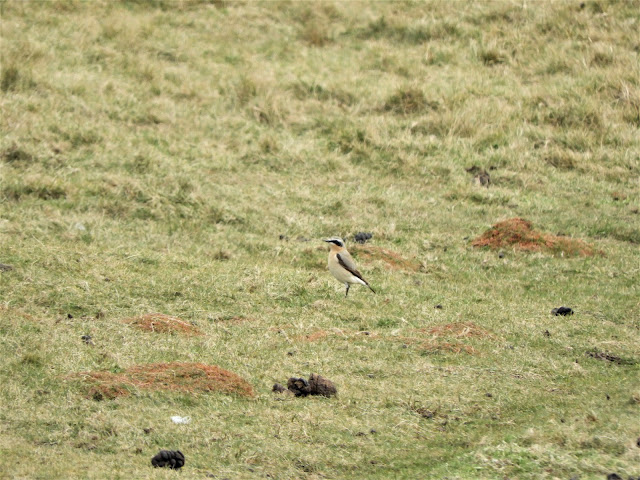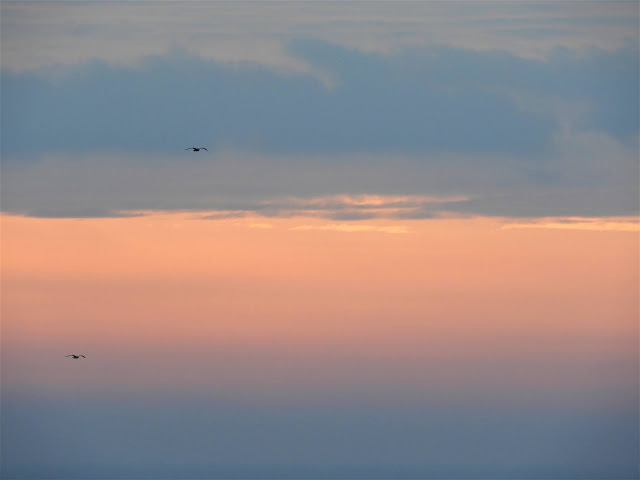Lundy Warden Dean Jones pens another colourful walk on Lundy's wild side…
Tuesday 16th March
A slight and chilly westerly breeze first thing, which brought some brief spells of sea-mist and fog in throughout the morning. The rest of the day saw glorious blue skies and sunshine, with the winds remaining low and swinging to a northerly orientation by the late morning. Max temperature 11°C.
Birding highlights included the first Swallow of the year, low over the Village around 15:00 hrs and the Pink-footed Goose, which has remained in and around Ackland's Moor marsh since the last blog post.
Other birds of note included a Great Northern Diver in the Landing Bay, 15 Teal on Pondsbury, small numbers of Lesser Black-backed Gulls moving north offshore in the afternoon (40), a single Puffin on the water in Jenny’s Cove – along with small numbers of both Guillemot and Razorbill onshore, two Woodpigeons, 96 Meadow Pipit, three each of Pied Wagtail, un-raced alba wagtail and Grey Wagtail, 17 Skylark, the Millcombe Firecrest, three Goldcrest, nine Blackbird, six Redwing, 13 Chaffinch and a single Goldfinch.
 |
Blackbird – Millcombe Valley came alive with bird song post sea-mist, 16 Feb © Dean Jones
|
There was no sign of the long-staying hibernicus-type Coal Tit despite searching for it. Fingers crossed the bird has managed to get back to the Emerald Isle safe and sound.
Wednesday 17th March
Blue skies and sunshine first thing with a light northerly wind – mostly overcast for the remainder of the day and a slight increase in wind speed by the evening. Max temperature 10°C.
Highlights included two each of Swallow and House Martin overhead late morning, the latter being the first of the year. The first Puffin to make landfall this year was also spotted amongst the Guillemots and Razorbills in Jenny’s Cove by 'Team Cargo' – Peter Hayes and Matt Scantlebury – in the afternoon, with a handful of others rafting together on the water also. Nearby, a Black Redstart was busily bobbing around Pyramid Slope, a single Great Northern Diver was again offshore along the east coast and the Pink-footed Goose remained on Ackland's Moor for its 12th day.
Other migrants of note included: two Golden Plover, eight Snipe (all flushed from the Pondsbury area), three Woodpigeon, 23 Skylark, 138 Meadow Pipit, two Pied and six un-raced alba wagtails, a single Grey Wagtail, two Chiffchaff, seven Goldcrest, the Firecrest still, 16 Blackbird, three Redwing, nine Stonechat, two Wheatear, six Chaffinch, five Goldfinch and four Linnet.
 |
| There's been lots of Peregrine action, with at least four pairs now defending territories across the island, 17 Mar © Dean Jones |
Non-avian sightings included the first Peacock butterfly of the year at St Helen’s Copse.
Thursday 18th March
A bright start with a chilly northerly breeze, which quickly turned murky with bouts of sea-fog rolling in periodically for the first few hours. The sun then re-emerged briefly by the late morning, before becoming overcast by the mid-afternoon as the wind picked up. Max temperature 9°C.
The morning saw the first decent fall of early spring migrants, the bulk of which came in the form of 22 Chiffchaff scattered around the island – some sporting conspicuous 'pollen horns'. Surprisingly, a rather early Willow Warbler also made landfall in St Helen’s Copse, six days earlier than the first of 2020, though six days behind the earliest ever record for this species on 10th Mar 1994. Other firsts for the year included a male Blackcap singing in Millcombe and a single White Wagtail above Benjamin’s Chair.
Although it is always a thrill to see the first Willow Warbler and Blackcap of the year, the day's star birds actually came in the form of two Long-tailed Tits in Quarter Wall Copse – only the fifth March occurrence of this species for Lundy. Here the birds were seen foraging through the smorgasbord of epiphytes covering the still-dormant trees in the copse before they headed north towards the Terrace and out of sight.
 |
Record shot of one of the Long-tailed Tits in Quarter Wall Copse, 18 Mar © Dean Jones
|
Other migrants logged included the Pink-footed Goose on Ackland's Moor for its 13th day, nine Teal on Pondsbury (including a number of displaying drakes), five Woodpigeon, 20 Skylark, a single Sand Martin over South West Field, 116 Meadow Pipit, four Grey Wagtail, six Pied Wagtails and two other un-raced alba wagtails, eight Goldcrest, the Firecrest again, eight Blackbird, singles of Redwing and Song Thrush, four Stonechat, eight Chaffinch, 19 Goldfinch (the highest count so far this year) and three Linnet.
 |
| Love is in the air at Pondsbury – courting Teal, 18 Mar © Dean Jones |
 |
18th Mar saw the highest count of Goldfinch so far this year, including this gorgeous
individual fresh in off the sea at Benjamin's Chair © Dean Jones |
Friday 19th March
After a misty sunrise, cloudy conditions set in for the rest of the day, though the sun did shine periodically throughout the afternoon. Moderate northerly wind in the morning dropping away gradually throughout the day. Max temperature 10°C.
 |
| The morning mist made for a spooky sunrise on 19 Mar © Dean Jones |
 |
| 19th Mar was certainly a day of awesome skies and seascapes, with Old Light reflected in Ackland's Moor marsh © Dean Jones |
A much quieter day for northbound migrants. Sightings of note included two Red-throated Divers behind Rat Island, a second-year Common Gull offshore along the east, eight Woodpigeon, 14 Skylark, 141 Meadow Pipit, two fly-over alba wagtails, eight Redwing, two Chiffchaff, the Millcombe Firecrest, eight Goldcrest, two Stonechat, four Chaffinch and six Goldfinch. There was no-sign of the Pink-footed Goose.
Saturday 20th March
The morning started off with barely a breath of wind, glass-like seas and mostly overcast conditions which became progressively brighter and slightly breezier as the day went on. Max temperature 9°C.
The day kicked off with a decent fall (for spring) of Goldcrest along the South End (41 birds in total by the end of the day), as well as two very handsome male Firecrests that found their way into the mist-nets in Millcombe first thing. Another was found flitting round Quarry Pond in the afternoon, resulting in a total of three birds for the day).
 |
| One of the two Firecrests caught and ringed in Millcombe on 20 Mar © Dean Jones |
Other early spring migrants logged included four Sand Martin together over Jenny’s Cove, a Blackcap on the Terrace, 11 Chiffchaff, the second White Wagtail of the year in Barton Field, a female Sparrowhawk in Millcombe (the first of the year), and 11 Fieldfare, 19 Redwing and a single Song Thrush spread between Barton and Helicopter Fields.
Additional highlights included the first Great Skua of the year past South West Point in the late morning, along with some small rafts of Manx Shearwater totalling 160 birds. The Great Northern Diver was once again in the Landing Bay and an excellent count of 29 Harbour Porpoise was spread along the west coast in the afternoon!
Other birds of note included small numbers of Kittiwake ashore in Jenny’s Cove, two Water Rail in Smelly Gully, seven Woodpigeon, 13 Skylark, 243 Meadow Pipit (including a flock of 82 birds in Brick Field), singles of Pied and Grey Wagtail, four Stonechat, eight Chaffinch and five Goldfinch.
Ringing totals: 15 Goldcrest, two Firecrest, three Chiffchaff, a single Chaffinch and three Robin.
 |
| The first Soay lambs have been born – here's one particularly adorable individual resting at Halfway Wall, 20 Mar © Dean Jones |
Sunday 21st March
A chilly, breezy and overcast start becoming sunny and warm by the early afternoon. The northerly winds also dropped away as the day went on. Max temperature 11°C.
 |
| A glorious spring afternoon looking across the Landing Bay, 21 Mar © Dean Jones |
Highlights included a Treecreeper – the first to be logged this year and only the third to be recorded in the month of March – foraging on a sycamore in Millcombe next to another Long-tailed Tit.
 |
The first Treecreeper of the year, Millcombe, 21 Mar © Dean Jones
|
Other sightings of note included singles of Manx Shearwater, Red-throated and Great Northern Diver offshore, 13 Teal on Pondsbury, five Woodpigeon, 75 Puffin in Jenny’s Cove (of which 25 were ashore), 24 Skylark, 167 Meadow Pipit, three Pied and one alba wagtail, a single Grey Wagtail, 17 Goldcrest, one Firecrest, four Chiffchaff, 26 Redwing, four Wheatear (including the first female bird of the year at Jenny’s Cove), four Stonechat, six Chaffinch, four Goldfinch and two Linnet.
 |
| More and more Puffins are starting to arrive at Jenny's Cove in preparation for a busy breeding season, 21 Mar © Dean Jones |
 |
A male Wheatear between bursts of song in Jenny's Cove, 21 Mar © Dean Jones
|
 |
| Tibby the Lundy Pony trying to get in on the Wheatear-watching action in Middle Park, 21 Mar © Dean Jones |
Monday 22nd March
Another windless start to the day, picking up to a gentle (and at times nippy) breeze by the afternoon. Mostly overcast first thing, giving way to sunshine and partially blue skies for the remainder of the day. Max temperature 11°C.
 |
| A brief hello from the sun between mist-net checks before it disappeared into the clouds, 22 Mar © Dean Jones |
A slightly quieter day for migrants, though Chiffchaff (23) and Goldcrest (20) were in decent numbers in Millcombe first thing. A singing Collared Dove near the gas store was the first of the year and the Long-tailed Tit from yesterday remained in Millcombe throughout the day.
 |
| Long-tailed Tit in Millcombe – the second record so far this spring! 22 Mar © Dean Jones |
Other sightings of note from a busy day painting Stoneycroft included five Carrion Crows leaving the island on a northward trajectory mid-morning (whilst at the same time others remained and were seen building nests along the east coast), a single Water Rail calling from the Secret Garden, four Woodpigeons, two fly-over alba wagtails and a handful of Meadow Pipits. Four Fieldfare and a single Redwing were foraging in Barton Field, four Linnet went overhead first thing, 10 Goldfinch dropped into Millcombe in mid-morning, and a single Siskin was calling from a pine tree in the valley later in the day.
Ringing totals: seven Chiffchaff, five Goldcrest, one Robin and a House Sparrow (the first to be colour-ringed this year).
 |
| Stoneycroft half painted by lunch time, 22 Mar © Dean Jones |
 |
| Finished! Just the windows to do now. Well done gang (l-r): Rosie, Pete and Matt from the Conservation Team © Dean Jones | |



















































